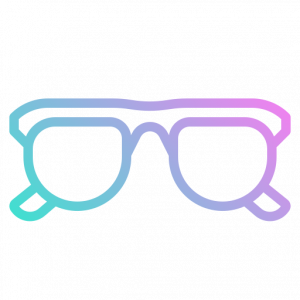Welcome to the
CHAPERONE Study
The CHAPERONE Study is testing
microdosed atropine eye solution for slowing
the progression of myopia in children.

Is your child nearsighted?
Nearsightedness, or myopia, is a condition that results in blurry vision when looking at distant objects.
Myopia happens when the eyeball grows too long or the cornea (the clear front cover of the eye) is too curved.
As a result, light entering the eye is not focused correctly. While glasses and contact lenses can help a person with myopia see clearly, they do not address the underlying stretching of the eye.
Myopia detected in young children tends to increase through the school years . As myopia progresses, it can increase the risk of retinal detachment, cataracts, myopia maculopathy and even blindness. To date, FDA has not approved any drug therapies for reducing myopia progression. This is why researchers are working to develop new medications and technologies that may help children and teens with this condition. The CHAPERONE Study is a research study testing the safety and effectiveness of microdosed atropine eye solution to see if it slows the progression of myopia in children.
What is the CHAPERONE Study?
The CHAPERONE Study is testing microdosed atropine eye solution for slowing the progression of myopia in children. Atropine eye drops are currently approved by FDA in the US to treat “lazy eye”; however, the medication is considered investigational in the CHAPERONE Study because it has not been approved specifically for reduction of myopia progression. In the CHAPERONE Study, a gentle mist is applied to each eye using a specialized dispenser. Each mist of the medication is about ¼ the volume of an eye drop. Participants in the CHAPERONE Study will use the study medication in both eyes every night, about one hour before bedtime.
Will it cost me anything to join the CHAPERONE Study?
No, you will not be charged for your child’s participation in the CHAPERONE Study. If your child qualifies and chooses to join the study, he/she will receive all study-related care at no cost. This includes the study medication, as well as any visits to your study doctor’s office, or tests performed during those visits. If your child’s vision changes and new glasses are needed, an allowance will be provided for this expense.
Has the study medication been used before?
Yes, atropine eye solution is currently approved by FDA in the US, but for a different reason – to treat “lazy” eye. The atropine eye solutions being tested in the CHAPERONE Study are less concentrated than the currently marketed solution. One of the solutions being tested (atropine 0.1%) is 1/10th as strong as the currently marketed version. The other solution being tested (atropine 0.01%) is 1/100th as strong. The atropine eye solutions used in the CHAPERONE Study are considered “investigational” because they have not been approved for reduction of myopia progression.
How many children will participate in the CHAPERONE Study?
About 420 children will take part in the study at select centers throughout the United States.
Why is there a 1 in 3 chance my child will receive the placebo solution for part of the study?
FDA has not approved any drug therapies for reducing myopia progression. A placebo is a solution that looks like study drug but does not contain active drug. The use of a placebo is common in clinical studies. It helps doctors and researchers better understand the true effects of the medication being studied. If your child receives placebo solution (1 in 3 chance) during the first part of the study, he/she will receive one of the atropine formulations after 3 years, and will continue to use this medication for the next year. Remember, your child will be closely monitored by the study doctor. If her/his nearsightedness gets worse during the study, you and the study doctor may decide to stop your child’s study participation to pursue other treatment options.
What if my child joins the CHAPERONE Study, but we decide not to participate anymore?
As with all clinical studies, your child’s participation is completely voluntary. Your child may leave the CHAPERONE Study at any time without any effect on his/her future medical care.
Who is sponsoring the study?
The study is being sponsored by Eyenovia, Inc. (www.eyenovia.com), an ophthalmic biopharmaceutical company (NASDAQ: EYEN) focused on developing new treatments for diseases in the front and back of the eye.
Initial Eligibility Requirements
- Is your child between 3-12 years old?
- Does your child need glasses to see distant objects?
- Is your child able to go to periodic visits at the study clinic to check his/her vision and overall eye health over a 4-year period (11 scheduled visits will be required)?
- Are you available to speak with study staff by phone periodically between your child’s clinic visits to review your child’s experience using study medication?
This study is not for children who have:
- Used atropine or other myopia drug therapies
- Had prior eye surgery
- A systemic disease or condition that can affect their vision
There are other requirements that the study doctor will review
with you to determine your child’s eligibility for this study.
Changes you may see at the CHAPERONE Study Sites in response to COVID-19
Before entering the facility, you and your child may be asked about symptoms you’ve experienced during the past weeks.
You may need to contact the clinic by phone or text from the parking lot before you can be admitted. Once admitted, you may be asked to use hand sanitizer and undergo a temperature check. You and your child will need to wear clean face masks.
You may either be immediately ushered into the examination room, or you may join a very limited number of socially distanced patients in the waiting room before being called for examination.
Study staff will be wearing face masks and gloves. The instrumentation used during your child’s examinations may have a protective shield to minimize exposure.
